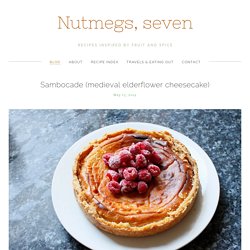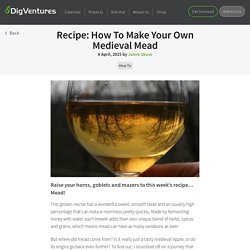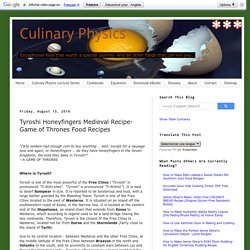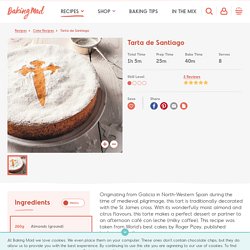

Savillum, Roman Cheesecake (Recipe) Sambocade, Medieval Cheesecake (Recipe) I had no idea how this would turn out; it’s very different to my usual baked cheesecake recipe.

It took quite a long time to fully set in the oven, but when it had emerged and cooled it was the most gorgeous thing, with a really wonderful dense, fudgy texture that was somehow airy and light at the same time. There was only a hint of rose and elderflower (you could add a bit more of these flavours if you like), but enough to make it sweet and delicate. Viking Bread (Recipe) When we chose Norway as the Scandinavian country we’d study for geography club, it was really all about the Vikings.

The clothes, longboats, food, and way of life is fascinating Really, what little boy could resist? My rough and tumble boy certainly wasn’t one to resist the topic, and frankly, my girls were just as excited about the study, and were all over the staged fights and raids too. And. Still. Interestingly, we learned that the Vikings may not have been as anti-Christian as they’ve been portrayed. Scholars believed, according to Williams, that the concentrated raids on Christian churches and monasteries had little to do with differences over religion and were more about the fact that they were places of wealth and little defense. In fact, once the Vikings settled {and took wives} in predominately Christian lands, they converted to Christianity very quickly. source We learned a lot about Vikings. Do you want to give it a try? Viking Bread Recipe Ingredients. Medieval Mead (Recipe) Raise your horns, goblets and mazers to this week’s recipe… Mead!

This golden nectar has a wonderful sweet, smooth taste and an usually high percentage that can induce merriness pretty quickly. Made by fermenting honey with water, each brewer adds their own unique blend of herbs, spices and grains, which means mead can have as many variations as beer. But where did mead come from? Is it really just a tasty medieval tipple, or do its origins go back even further? To find out, I stumbled off on a journey that took me from ancient China to modern-day Manchester. Mead in mythology The earliest evidence for the production of mead goes all the way back to 7,000 BC China, where archaeologists found traces of a fermented honey, rice and fruit beverage through the chemical analysis of pottery. The ancient Greeks also called it ‘ambrosia’ which meant immortal, and believed it to be the drink of the gods.
If life gives you honey…. Medieval Honeyfingers (Recipe) Featured Article Disclosure | Disclaimer |Comments Policy |Terms of Use | Privacy Policy| Blog Sitemap The information contained herein is provided as a public service with the understanding that this site makes no warranties, either expressed or implied, concerning the accuracy, completeness, reliability, or suitability of the information.

Nor does warrant that the use of this information is free of any claims of copyright infringement. This site do not endorse any commercial providers or their products. Culinary Physics Blog: Exceptional food that worth a special journey. 2011- 2016 All Rights Reserved. About Albert Ainstain Proposer une meilleure traduction. Medieval Gingerbread (Recipe) Renaissance Cookies (Recipe) Savoiarda, Biscotti, Sugar Cakes, and Jambals by Gael Stirler (July 17, 2013) For this issue I set out to find pre-17th century cookie recipes that you can make at home.

What we think of as a cookie is basically a small cake that is baked until crispy. Very few recipes for these dainty snacks exist prior to the 16th century. Of course the term cookie is relatively modern. The earliest recognizable recipe for a cookie is Ciambella de Monaco from Libro de Cucina, 1390, which is an ancestor to our Vanilla Wafers. Biscuits du Roy from The Accomplisht Cook, (1660) were made from a no-butter Sponge Cake batter and flavored with anis seed. Since it is important to remove all the moisture from these cookies so they will store well, this recipe includes a second baking at 250° to dry them out completely.
Savoiardi or Italian-style Lady Fingers Heat the oven to 350°F. Traditional English Crumpets (Recipe) As an Amazon Associate I earn from qualifying purchases. Crispy, chewy and delicately spongy in texture with a delicious depth of yeasty flavor, you simply can’t beat this authentic homemade crumpets recipe! Traditional Crumpets Recipe When I moved to England where I lived for 7 years, there were a number of quintessential British dishes I was eager to try. Crumpets was one of them. We had no sooner settled into our hotel room than we went grocery shopping at the local Tesco and I picked up a package of them for the following morning. The verdict: The butter and jam were good. Tarta de Santiago (Recipe) Originating from Galicia in North-Western Spain during the time of medieval pilgrimage, this tart is traditionally decorated with the St James cross.

With its wonderfully moist almond and citrus flavours, this torte makes a perfect dessert or partner to an afternoon café con leche (milky coffee). This recipe was taken from World's best cakes by Roger Pizey, published by Jacqui Small. Method Preheat the oven to 170°C (fan 150°C, gas mark 3) and grease an 28cm (11in) springform cake tin. Cream 180g (6½oz) of the sugar, zests and egg yolks together until light and fluffy. Let's Bake The easiest way to follow a recipe Reviews Linda Bostock 25 May 2019 5 star rating Tried this at a friends Delicious. Leave Your Thoughts.